Lab Report on Transpiration
VerifiedAdded on 2023/05/31
|12
|1770
|230
AI Summary
This lab report analyzes the rate of transpiration in different environmental conditions. The experiment involved measuring the rate of water loss in plant shoots placed in normal, windy, hot, and humid conditions. The results showed that high temperature and wind increased the rate of transpiration, while humidity reduced it. The report also discusses the physiological and structural adaptations of plants to cope with transpiration.
Contribute Materials
Your contribution can guide someone’s learning journey. Share your
documents today.
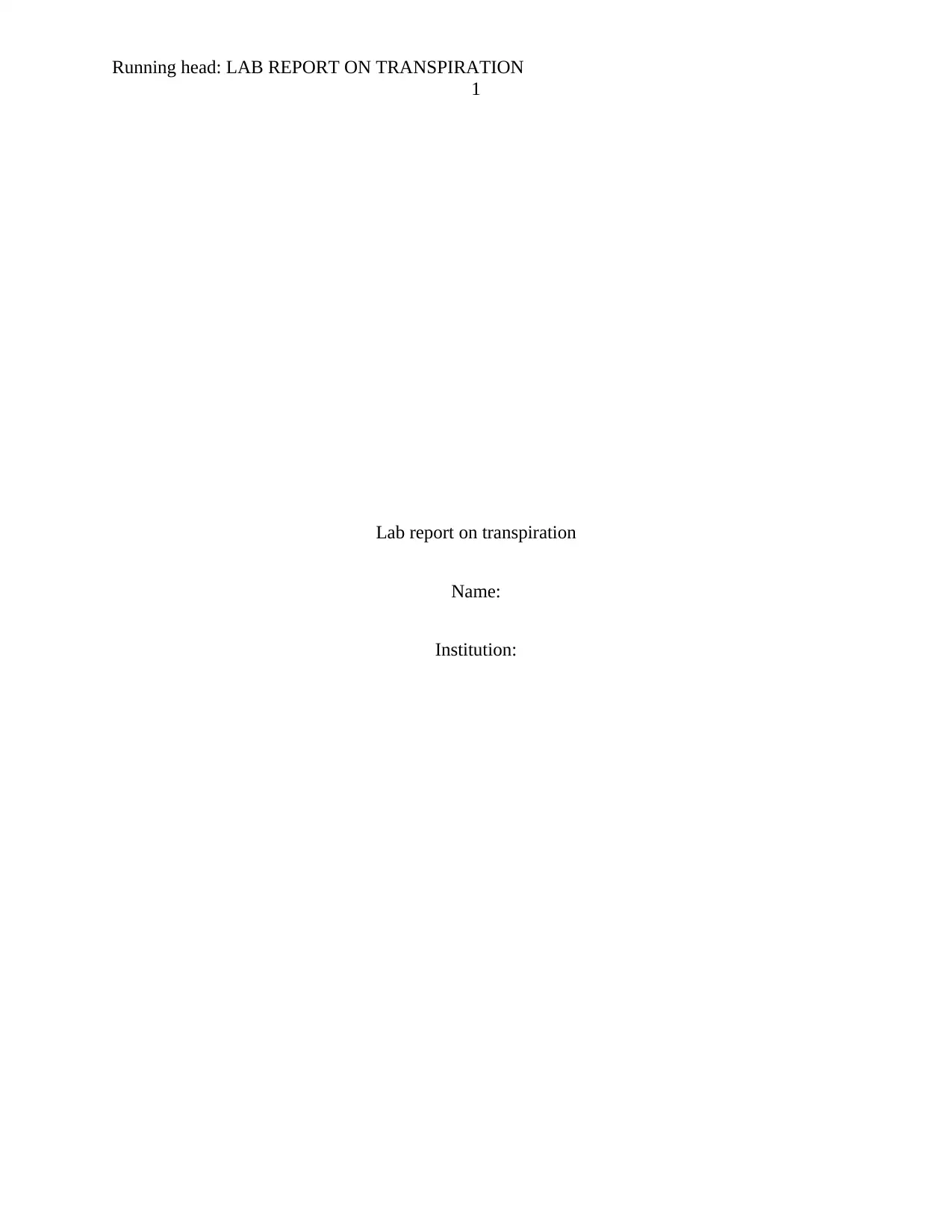
Running head: LAB REPORT ON TRANSPIRATION
1
Lab report on transpiration
Name:
Institution:
1
Lab report on transpiration
Name:
Institution:
Secure Best Marks with AI Grader
Need help grading? Try our AI Grader for instant feedback on your assignments.
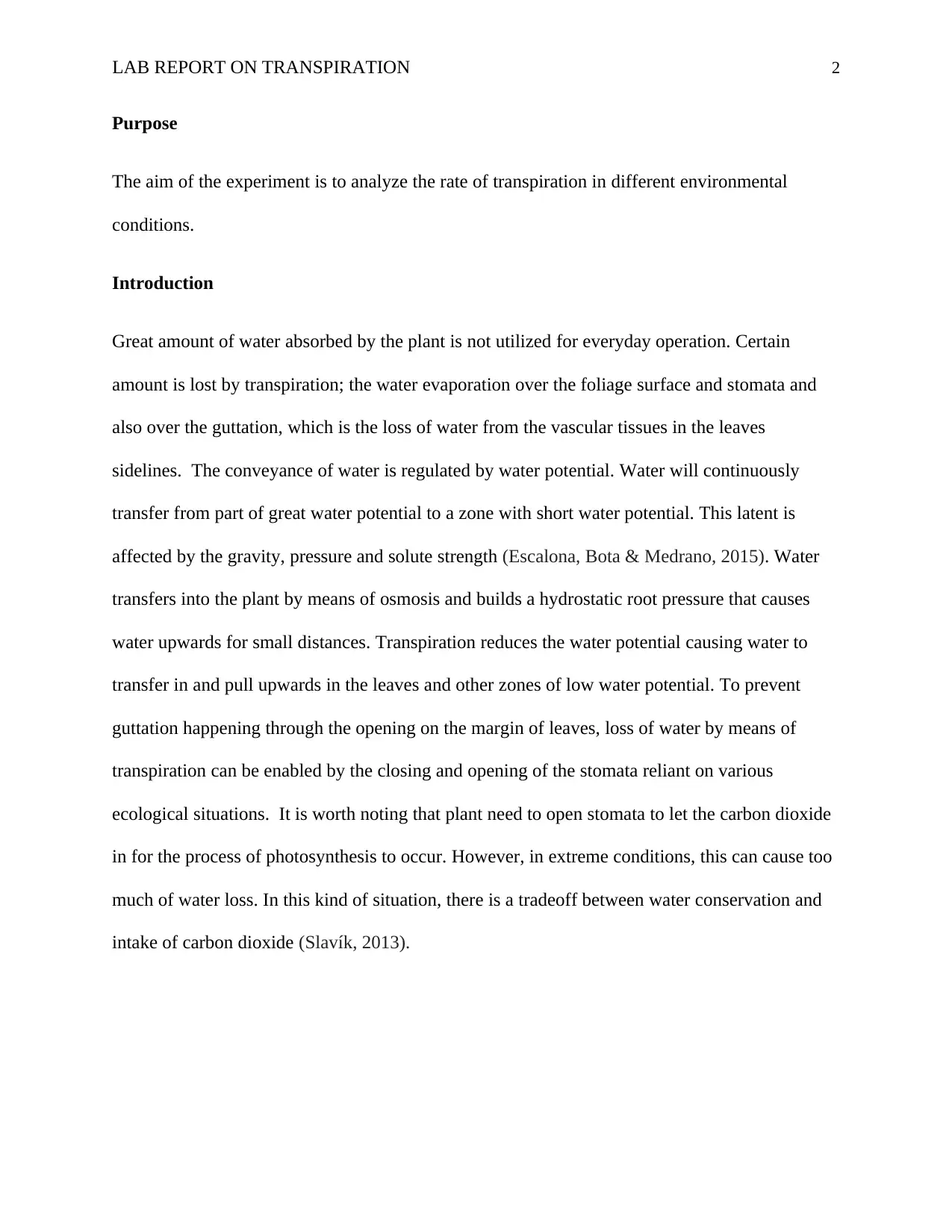
LAB REPORT ON TRANSPIRATION 2
Purpose
The aim of the experiment is to analyze the rate of transpiration in different environmental
conditions.
Introduction
Great amount of water absorbed by the plant is not utilized for everyday operation. Certain
amount is lost by transpiration; the water evaporation over the foliage surface and stomata and
also over the guttation, which is the loss of water from the vascular tissues in the leaves
sidelines. The conveyance of water is regulated by water potential. Water will continuously
transfer from part of great water potential to a zone with short water potential. This latent is
affected by the gravity, pressure and solute strength (Escalona, Bota & Medrano, 2015). Water
transfers into the plant by means of osmosis and builds a hydrostatic root pressure that causes
water upwards for small distances. Transpiration reduces the water potential causing water to
transfer in and pull upwards in the leaves and other zones of low water potential. To prevent
guttation happening through the opening on the margin of leaves, loss of water by means of
transpiration can be enabled by the closing and opening of the stomata reliant on various
ecological situations. It is worth noting that plant need to open stomata to let the carbon dioxide
in for the process of photosynthesis to occur. However, in extreme conditions, this can cause too
much of water loss. In this kind of situation, there is a tradeoff between water conservation and
intake of carbon dioxide (Slavík, 2013).
Purpose
The aim of the experiment is to analyze the rate of transpiration in different environmental
conditions.
Introduction
Great amount of water absorbed by the plant is not utilized for everyday operation. Certain
amount is lost by transpiration; the water evaporation over the foliage surface and stomata and
also over the guttation, which is the loss of water from the vascular tissues in the leaves
sidelines. The conveyance of water is regulated by water potential. Water will continuously
transfer from part of great water potential to a zone with short water potential. This latent is
affected by the gravity, pressure and solute strength (Escalona, Bota & Medrano, 2015). Water
transfers into the plant by means of osmosis and builds a hydrostatic root pressure that causes
water upwards for small distances. Transpiration reduces the water potential causing water to
transfer in and pull upwards in the leaves and other zones of low water potential. To prevent
guttation happening through the opening on the margin of leaves, loss of water by means of
transpiration can be enabled by the closing and opening of the stomata reliant on various
ecological situations. It is worth noting that plant need to open stomata to let the carbon dioxide
in for the process of photosynthesis to occur. However, in extreme conditions, this can cause too
much of water loss. In this kind of situation, there is a tradeoff between water conservation and
intake of carbon dioxide (Slavík, 2013).
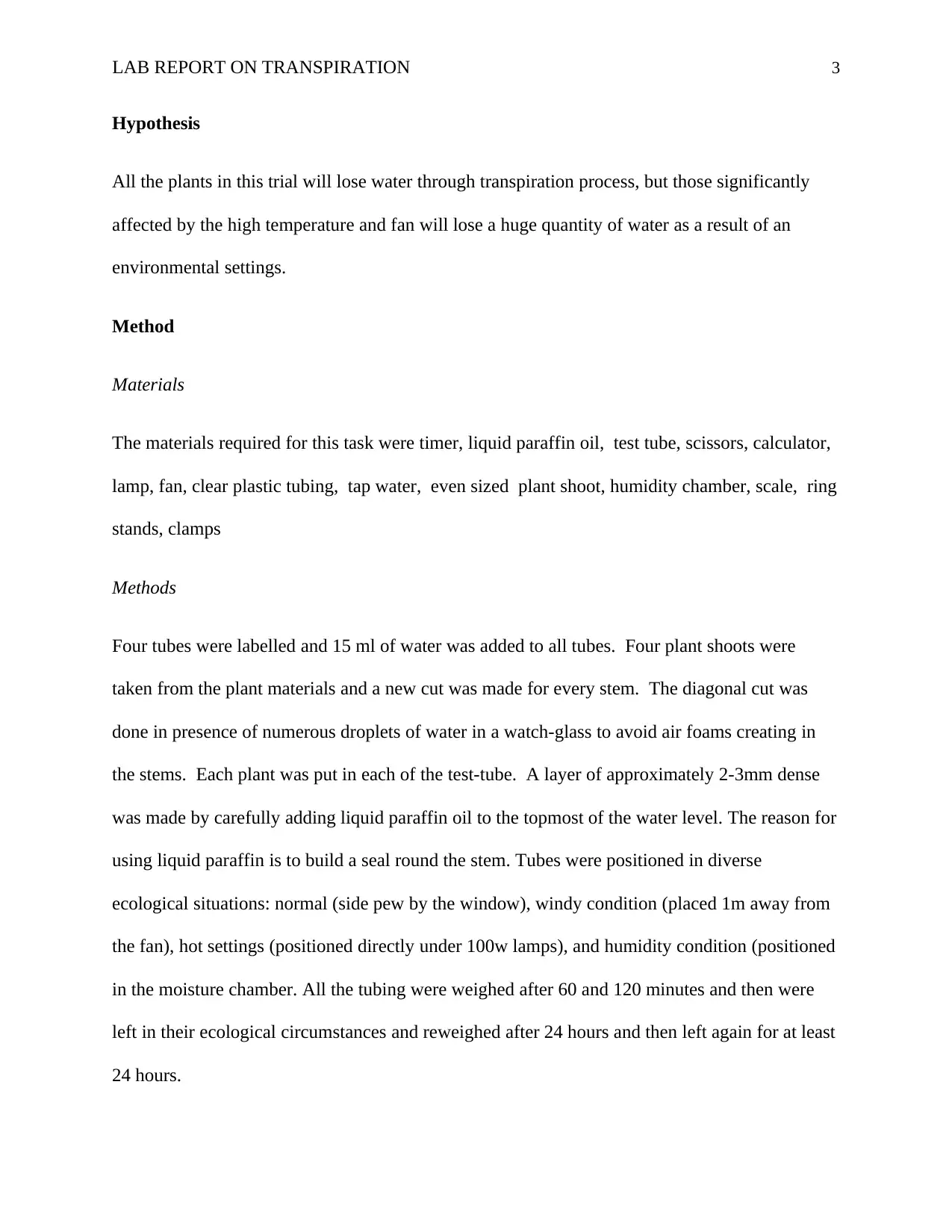
LAB REPORT ON TRANSPIRATION 3
Hypothesis
All the plants in this trial will lose water through transpiration process, but those significantly
affected by the high temperature and fan will lose a huge quantity of water as a result of an
environmental settings.
Method
Materials
The materials required for this task were timer, liquid paraffin oil, test tube, scissors, calculator,
lamp, fan, clear plastic tubing, tap water, even sized plant shoot, humidity chamber, scale, ring
stands, clamps
Methods
Four tubes were labelled and 15 ml of water was added to all tubes. Four plant shoots were
taken from the plant materials and a new cut was made for every stem. The diagonal cut was
done in presence of numerous droplets of water in a watch-glass to avoid air foams creating in
the stems. Each plant was put in each of the test-tube. A layer of approximately 2-3mm dense
was made by carefully adding liquid paraffin oil to the topmost of the water level. The reason for
using liquid paraffin is to build a seal round the stem. Tubes were positioned in diverse
ecological situations: normal (side pew by the window), windy condition (placed 1m away from
the fan), hot settings (positioned directly under 100w lamps), and humidity condition (positioned
in the moisture chamber. All the tubing were weighed after 60 and 120 minutes and then were
left in their ecological circumstances and reweighed after 24 hours and then left again for at least
24 hours.
Hypothesis
All the plants in this trial will lose water through transpiration process, but those significantly
affected by the high temperature and fan will lose a huge quantity of water as a result of an
environmental settings.
Method
Materials
The materials required for this task were timer, liquid paraffin oil, test tube, scissors, calculator,
lamp, fan, clear plastic tubing, tap water, even sized plant shoot, humidity chamber, scale, ring
stands, clamps
Methods
Four tubes were labelled and 15 ml of water was added to all tubes. Four plant shoots were
taken from the plant materials and a new cut was made for every stem. The diagonal cut was
done in presence of numerous droplets of water in a watch-glass to avoid air foams creating in
the stems. Each plant was put in each of the test-tube. A layer of approximately 2-3mm dense
was made by carefully adding liquid paraffin oil to the topmost of the water level. The reason for
using liquid paraffin is to build a seal round the stem. Tubes were positioned in diverse
ecological situations: normal (side pew by the window), windy condition (placed 1m away from
the fan), hot settings (positioned directly under 100w lamps), and humidity condition (positioned
in the moisture chamber. All the tubing were weighed after 60 and 120 minutes and then were
left in their ecological circumstances and reweighed after 24 hours and then left again for at least
24 hours.
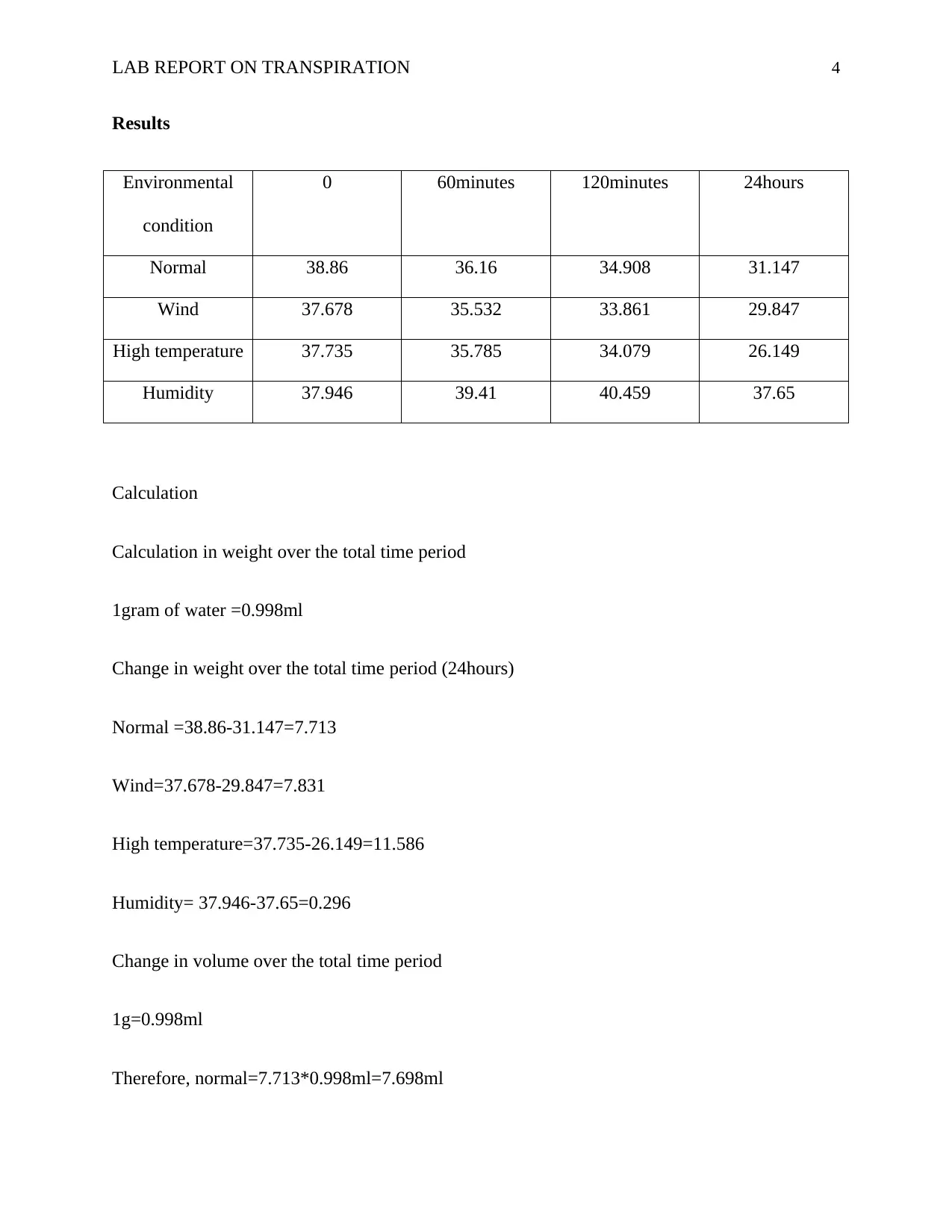
LAB REPORT ON TRANSPIRATION 4
Results
Environmental
condition
0 60minutes 120minutes 24hours
Normal 38.86 36.16 34.908 31.147
Wind 37.678 35.532 33.861 29.847
High temperature 37.735 35.785 34.079 26.149
Humidity 37.946 39.41 40.459 37.65
Calculation
Calculation in weight over the total time period
1gram of water =0.998ml
Change in weight over the total time period (24hours)
Normal =38.86-31.147=7.713
Wind=37.678-29.847=7.831
High temperature=37.735-26.149=11.586
Humidity= 37.946-37.65=0.296
Change in volume over the total time period
1g=0.998ml
Therefore, normal=7.713*0.998ml=7.698ml
Results
Environmental
condition
0 60minutes 120minutes 24hours
Normal 38.86 36.16 34.908 31.147
Wind 37.678 35.532 33.861 29.847
High temperature 37.735 35.785 34.079 26.149
Humidity 37.946 39.41 40.459 37.65
Calculation
Calculation in weight over the total time period
1gram of water =0.998ml
Change in weight over the total time period (24hours)
Normal =38.86-31.147=7.713
Wind=37.678-29.847=7.831
High temperature=37.735-26.149=11.586
Humidity= 37.946-37.65=0.296
Change in volume over the total time period
1g=0.998ml
Therefore, normal=7.713*0.998ml=7.698ml
Secure Best Marks with AI Grader
Need help grading? Try our AI Grader for instant feedback on your assignments.
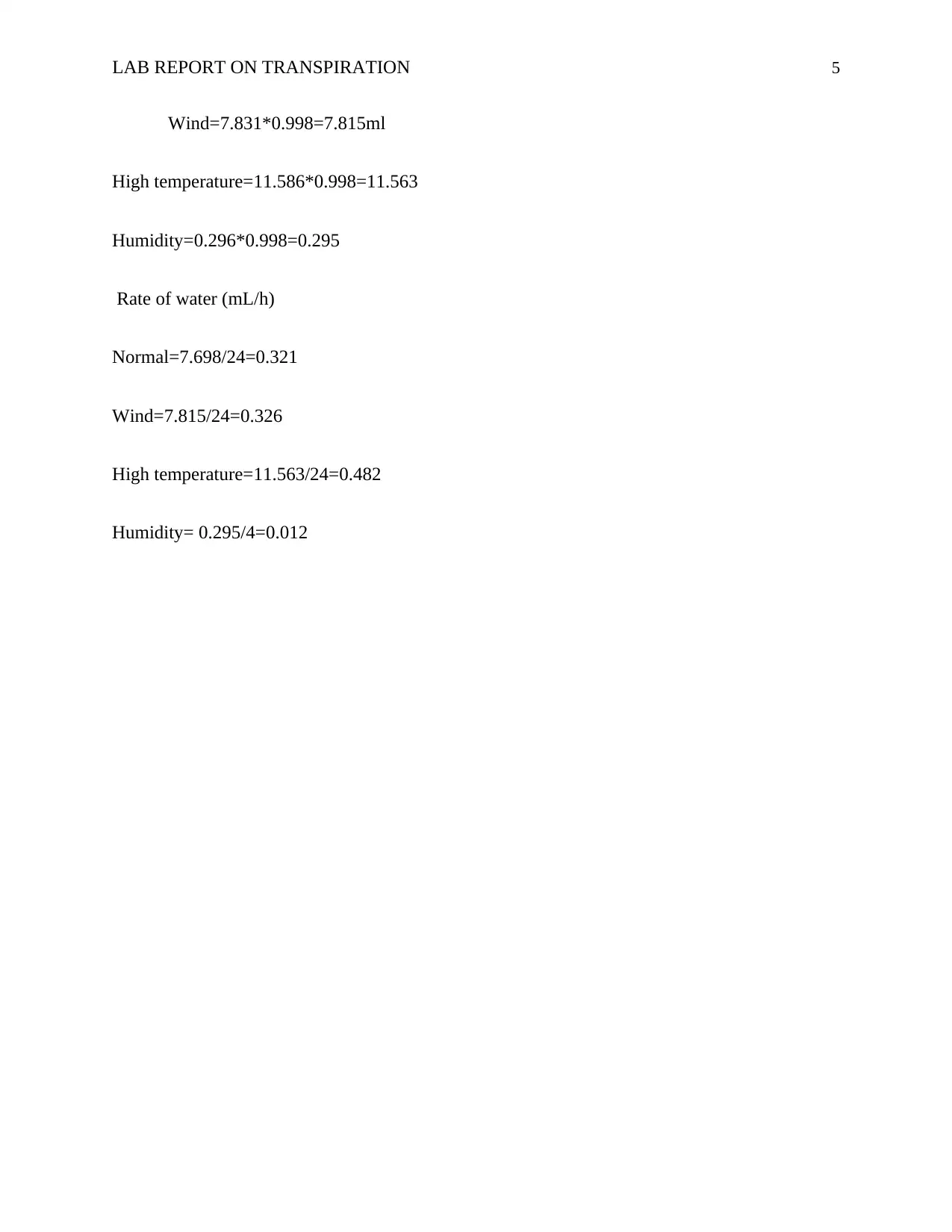
LAB REPORT ON TRANSPIRATION 5
Wind=7.831*0.998=7.815ml
High temperature=11.586*0.998=11.563
Humidity=0.296*0.998=0.295
Rate of water (mL/h)
Normal=7.698/24=0.321
Wind=7.815/24=0.326
High temperature=11.563/24=0.482
Humidity= 0.295/4=0.012
Wind=7.831*0.998=7.815ml
High temperature=11.586*0.998=11.563
Humidity=0.296*0.998=0.295
Rate of water (mL/h)
Normal=7.698/24=0.321
Wind=7.815/24=0.326
High temperature=11.563/24=0.482
Humidity= 0.295/4=0.012
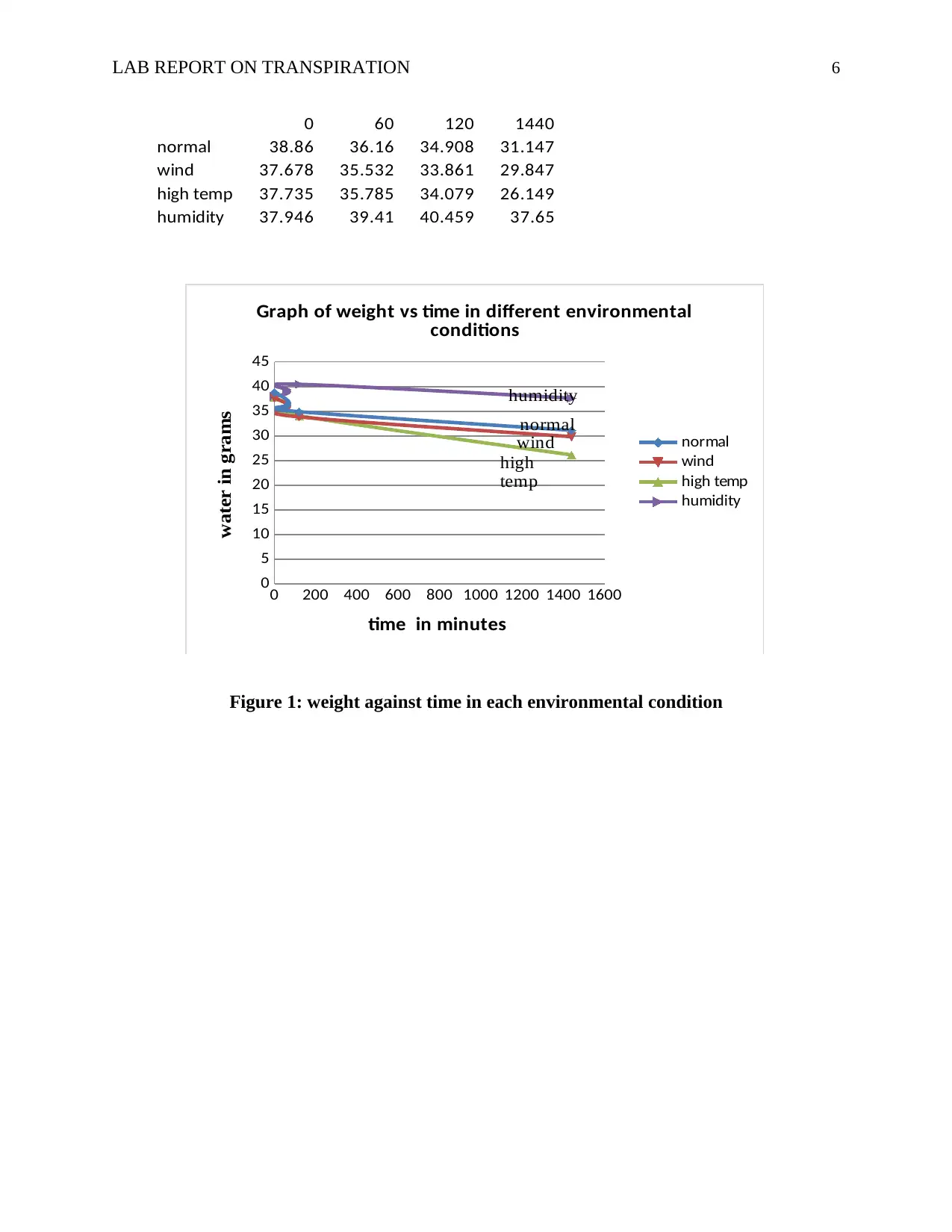
LAB REPORT ON TRANSPIRATION 6
0 60 120 1440
normal 38.86 36.16 34.908 31.147
wind 37.678 35.532 33.861 29.847
high temp 37.735 35.785 34.079 26.149
humidity 37.946 39.41 40.459 37.65
0 200 400 600 800 1000 1200 1400 1600
0
5
10
15
20
25
30
35
40
45
Graph of weight vs time in different environmental
conditions
normal
wind
high temp
humidity
time in minutes
water in grams humidity
normal
wind
high
temp
Figure 1: weight against time in each environmental condition
0 60 120 1440
normal 38.86 36.16 34.908 31.147
wind 37.678 35.532 33.861 29.847
high temp 37.735 35.785 34.079 26.149
humidity 37.946 39.41 40.459 37.65
0 200 400 600 800 1000 1200 1400 1600
0
5
10
15
20
25
30
35
40
45
Graph of weight vs time in different environmental
conditions
normal
wind
high temp
humidity
time in minutes
water in grams humidity
normal
wind
high
temp
Figure 1: weight against time in each environmental condition
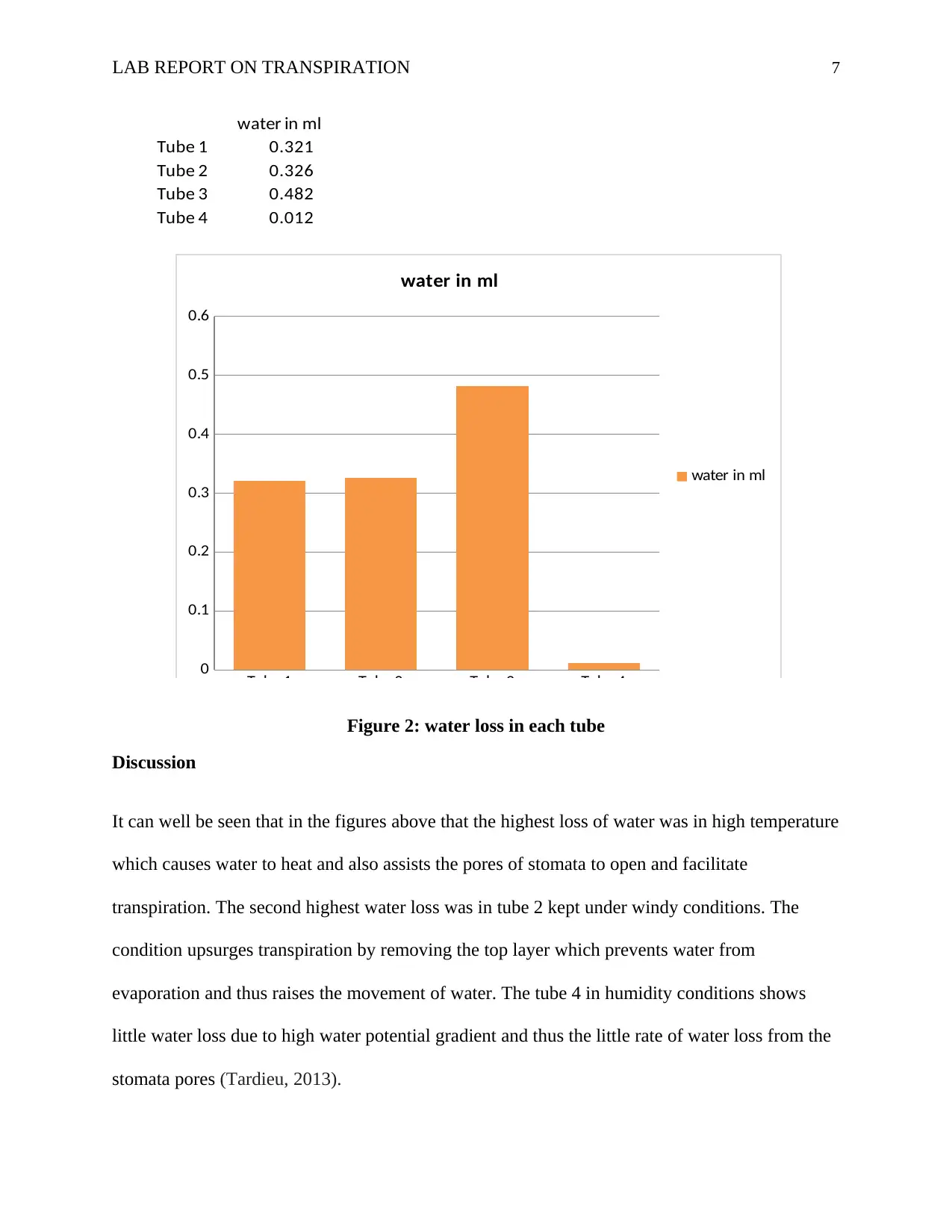
LAB REPORT ON TRANSPIRATION 7
water in ml
Tube 1 0.321
Tube 2 0.326
Tube 3 0.482
Tube 4 0.012
Tube 1 Tube 2 Tube 3 Tube 4
0
0.1
0.2
0.3
0.4
0.5
0.6
water in ml
water in ml
Figure 2: water loss in each tube
Discussion
It can well be seen that in the figures above that the highest loss of water was in high temperature
which causes water to heat and also assists the pores of stomata to open and facilitate
transpiration. The second highest water loss was in tube 2 kept under windy conditions. The
condition upsurges transpiration by removing the top layer which prevents water from
evaporation and thus raises the movement of water. The tube 4 in humidity conditions shows
little water loss due to high water potential gradient and thus the little rate of water loss from the
stomata pores (Tardieu, 2013).
water in ml
Tube 1 0.321
Tube 2 0.326
Tube 3 0.482
Tube 4 0.012
Tube 1 Tube 2 Tube 3 Tube 4
0
0.1
0.2
0.3
0.4
0.5
0.6
water in ml
water in ml
Figure 2: water loss in each tube
Discussion
It can well be seen that in the figures above that the highest loss of water was in high temperature
which causes water to heat and also assists the pores of stomata to open and facilitate
transpiration. The second highest water loss was in tube 2 kept under windy conditions. The
condition upsurges transpiration by removing the top layer which prevents water from
evaporation and thus raises the movement of water. The tube 4 in humidity conditions shows
little water loss due to high water potential gradient and thus the little rate of water loss from the
stomata pores (Tardieu, 2013).
Paraphrase This Document
Need a fresh take? Get an instant paraphrase of this document with our AI Paraphraser
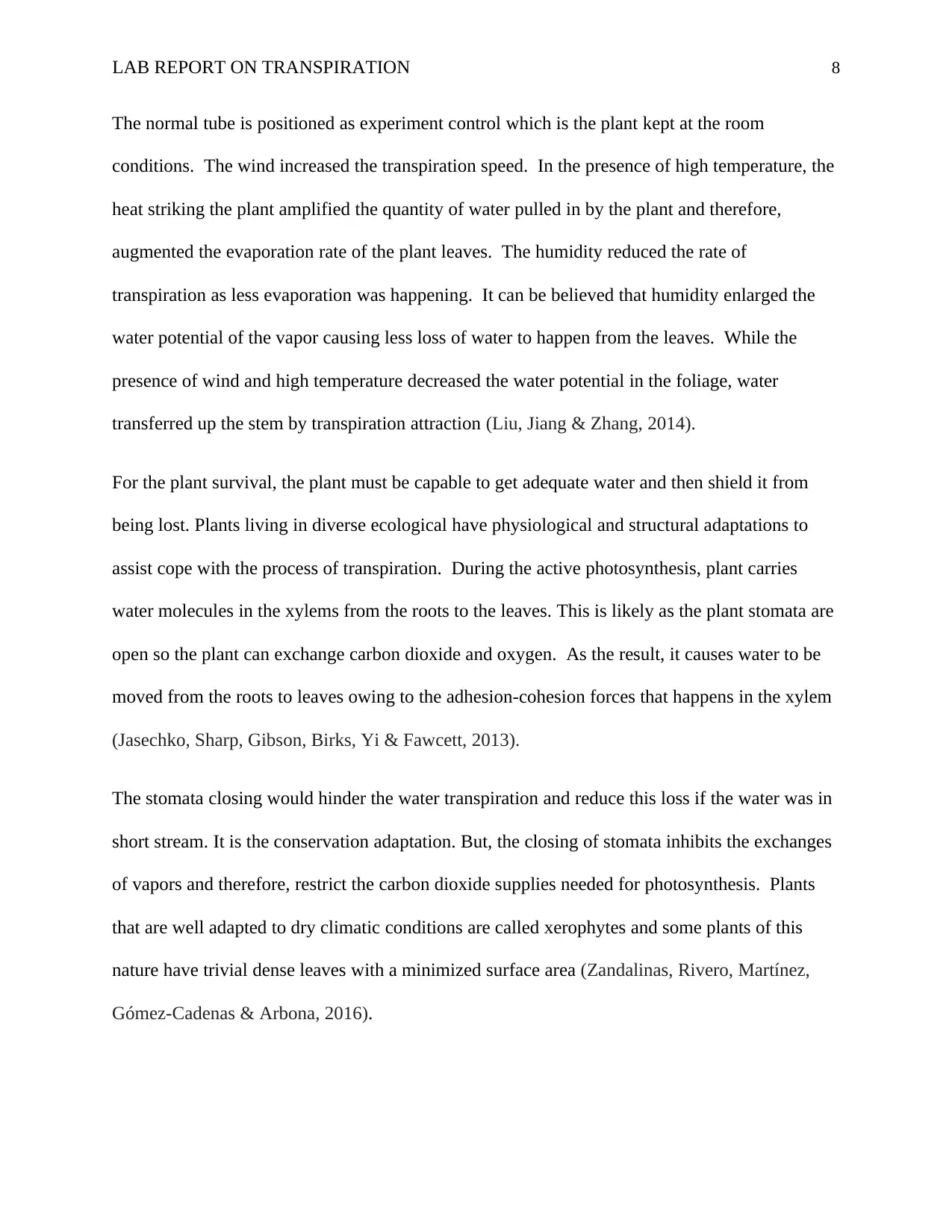
LAB REPORT ON TRANSPIRATION 8
The normal tube is positioned as experiment control which is the plant kept at the room
conditions. The wind increased the transpiration speed. In the presence of high temperature, the
heat striking the plant amplified the quantity of water pulled in by the plant and therefore,
augmented the evaporation rate of the plant leaves. The humidity reduced the rate of
transpiration as less evaporation was happening. It can be believed that humidity enlarged the
water potential of the vapor causing less loss of water to happen from the leaves. While the
presence of wind and high temperature decreased the water potential in the foliage, water
transferred up the stem by transpiration attraction (Liu, Jiang & Zhang, 2014).
For the plant survival, the plant must be capable to get adequate water and then shield it from
being lost. Plants living in diverse ecological have physiological and structural adaptations to
assist cope with the process of transpiration. During the active photosynthesis, plant carries
water molecules in the xylems from the roots to the leaves. This is likely as the plant stomata are
open so the plant can exchange carbon dioxide and oxygen. As the result, it causes water to be
moved from the roots to leaves owing to the adhesion-cohesion forces that happens in the xylem
(Jasechko, Sharp, Gibson, Birks, Yi & Fawcett, 2013).
The stomata closing would hinder the water transpiration and reduce this loss if the water was in
short stream. It is the conservation adaptation. But, the closing of stomata inhibits the exchanges
of vapors and therefore, restrict the carbon dioxide supplies needed for photosynthesis. Plants
that are well adapted to dry climatic conditions are called xerophytes and some plants of this
nature have trivial dense leaves with a minimized surface area (Zandalinas, Rivero, Martínez,
Gómez-Cadenas & Arbona, 2016).
The normal tube is positioned as experiment control which is the plant kept at the room
conditions. The wind increased the transpiration speed. In the presence of high temperature, the
heat striking the plant amplified the quantity of water pulled in by the plant and therefore,
augmented the evaporation rate of the plant leaves. The humidity reduced the rate of
transpiration as less evaporation was happening. It can be believed that humidity enlarged the
water potential of the vapor causing less loss of water to happen from the leaves. While the
presence of wind and high temperature decreased the water potential in the foliage, water
transferred up the stem by transpiration attraction (Liu, Jiang & Zhang, 2014).
For the plant survival, the plant must be capable to get adequate water and then shield it from
being lost. Plants living in diverse ecological have physiological and structural adaptations to
assist cope with the process of transpiration. During the active photosynthesis, plant carries
water molecules in the xylems from the roots to the leaves. This is likely as the plant stomata are
open so the plant can exchange carbon dioxide and oxygen. As the result, it causes water to be
moved from the roots to leaves owing to the adhesion-cohesion forces that happens in the xylem
(Jasechko, Sharp, Gibson, Birks, Yi & Fawcett, 2013).
The stomata closing would hinder the water transpiration and reduce this loss if the water was in
short stream. It is the conservation adaptation. But, the closing of stomata inhibits the exchanges
of vapors and therefore, restrict the carbon dioxide supplies needed for photosynthesis. Plants
that are well adapted to dry climatic conditions are called xerophytes and some plants of this
nature have trivial dense leaves with a minimized surface area (Zandalinas, Rivero, Martínez,
Gómez-Cadenas & Arbona, 2016).
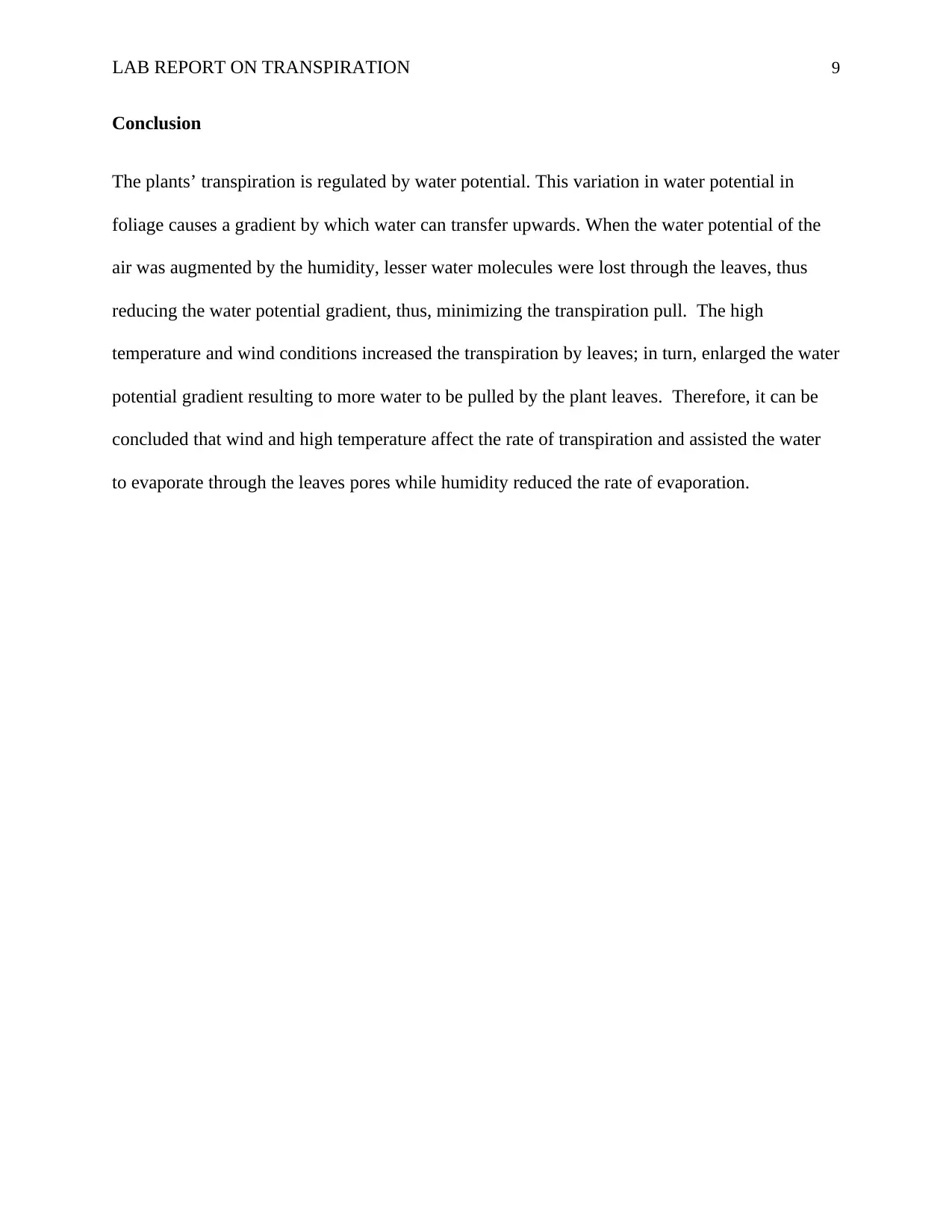
LAB REPORT ON TRANSPIRATION 9
Conclusion
The plants’ transpiration is regulated by water potential. This variation in water potential in
foliage causes a gradient by which water can transfer upwards. When the water potential of the
air was augmented by the humidity, lesser water molecules were lost through the leaves, thus
reducing the water potential gradient, thus, minimizing the transpiration pull. The high
temperature and wind conditions increased the transpiration by leaves; in turn, enlarged the water
potential gradient resulting to more water to be pulled by the plant leaves. Therefore, it can be
concluded that wind and high temperature affect the rate of transpiration and assisted the water
to evaporate through the leaves pores while humidity reduced the rate of evaporation.
Conclusion
The plants’ transpiration is regulated by water potential. This variation in water potential in
foliage causes a gradient by which water can transfer upwards. When the water potential of the
air was augmented by the humidity, lesser water molecules were lost through the leaves, thus
reducing the water potential gradient, thus, minimizing the transpiration pull. The high
temperature and wind conditions increased the transpiration by leaves; in turn, enlarged the water
potential gradient resulting to more water to be pulled by the plant leaves. Therefore, it can be
concluded that wind and high temperature affect the rate of transpiration and assisted the water
to evaporate through the leaves pores while humidity reduced the rate of evaporation.
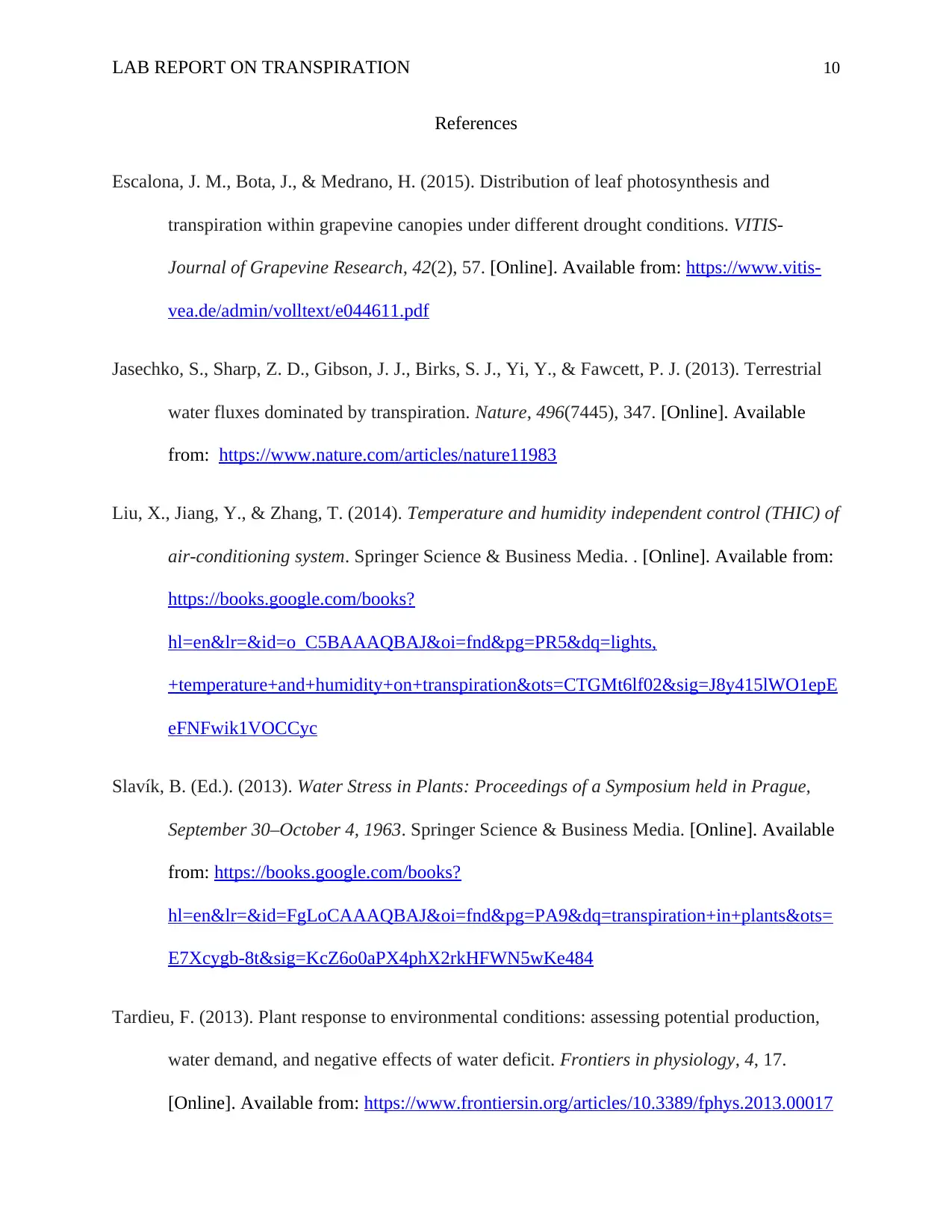
LAB REPORT ON TRANSPIRATION 10
References
Escalona, J. M., Bota, J., & Medrano, H. (2015). Distribution of leaf photosynthesis and
transpiration within grapevine canopies under different drought conditions. VITIS-
Journal of Grapevine Research, 42(2), 57. [Online]. Available from: https://www.vitis-
vea.de/admin/volltext/e044611.pdf
Jasechko, S., Sharp, Z. D., Gibson, J. J., Birks, S. J., Yi, Y., & Fawcett, P. J. (2013). Terrestrial
water fluxes dominated by transpiration. Nature, 496(7445), 347. [Online]. Available
from: https://www.nature.com/articles/nature11983
Liu, X., Jiang, Y., & Zhang, T. (2014). Temperature and humidity independent control (THIC) of
air-conditioning system. Springer Science & Business Media. . [Online]. Available from:
https://books.google.com/books?
hl=en&lr=&id=o_C5BAAAQBAJ&oi=fnd&pg=PR5&dq=lights,
+temperature+and+humidity+on+transpiration&ots=CTGMt6lf02&sig=J8y415lWO1epE
eFNFwik1VOCCyc
Slavík, B. (Ed.). (2013). Water Stress in Plants: Proceedings of a Symposium held in Prague,
September 30–October 4, 1963. Springer Science & Business Media. [Online]. Available
from: https://books.google.com/books?
hl=en&lr=&id=FgLoCAAAQBAJ&oi=fnd&pg=PA9&dq=transpiration+in+plants&ots=
E7Xcygb-8t&sig=KcZ6o0aPX4phX2rkHFWN5wKe484
Tardieu, F. (2013). Plant response to environmental conditions: assessing potential production,
water demand, and negative effects of water deficit. Frontiers in physiology, 4, 17.
[Online]. Available from: https://www.frontiersin.org/articles/10.3389/fphys.2013.00017
References
Escalona, J. M., Bota, J., & Medrano, H. (2015). Distribution of leaf photosynthesis and
transpiration within grapevine canopies under different drought conditions. VITIS-
Journal of Grapevine Research, 42(2), 57. [Online]. Available from: https://www.vitis-
vea.de/admin/volltext/e044611.pdf
Jasechko, S., Sharp, Z. D., Gibson, J. J., Birks, S. J., Yi, Y., & Fawcett, P. J. (2013). Terrestrial
water fluxes dominated by transpiration. Nature, 496(7445), 347. [Online]. Available
from: https://www.nature.com/articles/nature11983
Liu, X., Jiang, Y., & Zhang, T. (2014). Temperature and humidity independent control (THIC) of
air-conditioning system. Springer Science & Business Media. . [Online]. Available from:
https://books.google.com/books?
hl=en&lr=&id=o_C5BAAAQBAJ&oi=fnd&pg=PR5&dq=lights,
+temperature+and+humidity+on+transpiration&ots=CTGMt6lf02&sig=J8y415lWO1epE
eFNFwik1VOCCyc
Slavík, B. (Ed.). (2013). Water Stress in Plants: Proceedings of a Symposium held in Prague,
September 30–October 4, 1963. Springer Science & Business Media. [Online]. Available
from: https://books.google.com/books?
hl=en&lr=&id=FgLoCAAAQBAJ&oi=fnd&pg=PA9&dq=transpiration+in+plants&ots=
E7Xcygb-8t&sig=KcZ6o0aPX4phX2rkHFWN5wKe484
Tardieu, F. (2013). Plant response to environmental conditions: assessing potential production,
water demand, and negative effects of water deficit. Frontiers in physiology, 4, 17.
[Online]. Available from: https://www.frontiersin.org/articles/10.3389/fphys.2013.00017
Secure Best Marks with AI Grader
Need help grading? Try our AI Grader for instant feedback on your assignments.
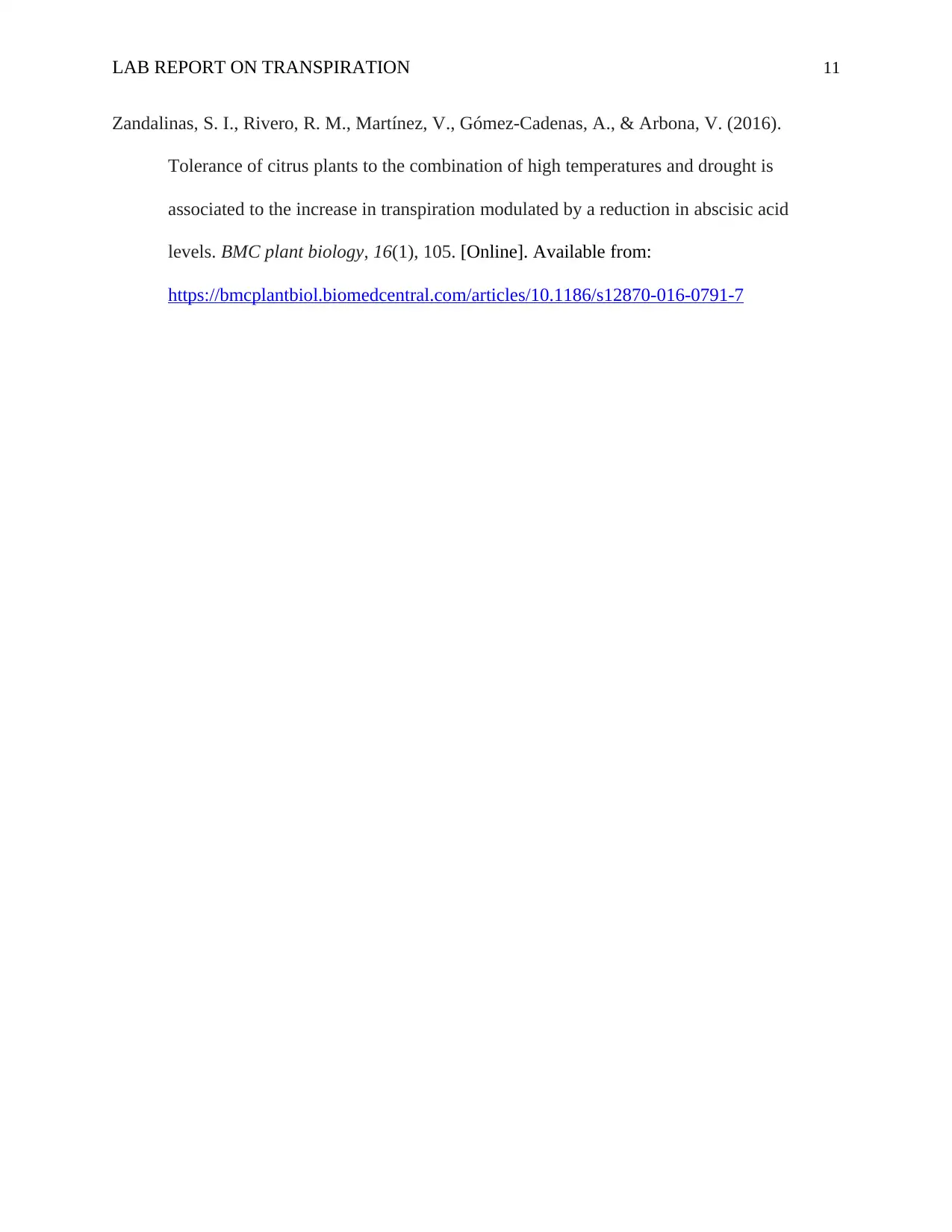
LAB REPORT ON TRANSPIRATION 11
Zandalinas, S. I., Rivero, R. M., Martínez, V., Gómez-Cadenas, A., & Arbona, V. (2016).
Tolerance of citrus plants to the combination of high temperatures and drought is
associated to the increase in transpiration modulated by a reduction in abscisic acid
levels. BMC plant biology, 16(1), 105. [Online]. Available from:
https://bmcplantbiol.biomedcentral.com/articles/10.1186/s12870-016-0791-7
Zandalinas, S. I., Rivero, R. M., Martínez, V., Gómez-Cadenas, A., & Arbona, V. (2016).
Tolerance of citrus plants to the combination of high temperatures and drought is
associated to the increase in transpiration modulated by a reduction in abscisic acid
levels. BMC plant biology, 16(1), 105. [Online]. Available from:
https://bmcplantbiol.biomedcentral.com/articles/10.1186/s12870-016-0791-7

LAB REPORT ON TRANSPIRATION 12
1 out of 12
Related Documents
Your All-in-One AI-Powered Toolkit for Academic Success.
+13062052269
info@desklib.com
Available 24*7 on WhatsApp / Email
![[object Object]](/_next/static/media/star-bottom.7253800d.svg)
Unlock your academic potential
© 2024 | Zucol Services PVT LTD | All rights reserved.
